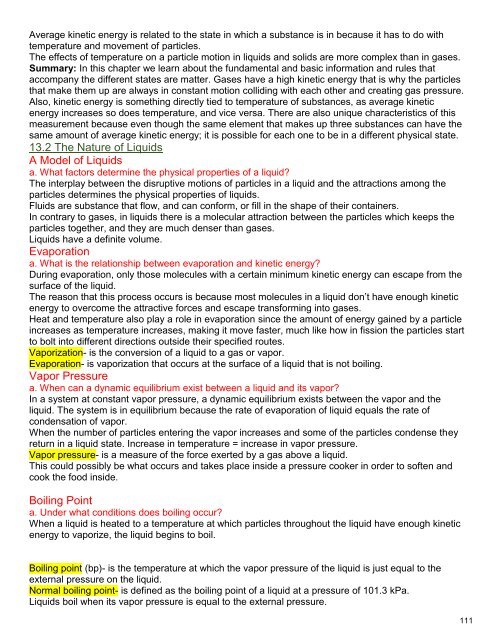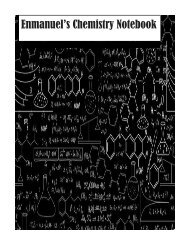Create successful ePaper yourself
Turn your PDF publications into a flip-book with our unique Google optimized e-Paper software.
Average kinetic energy is related to the state in which a substance is in because it has to do with<br />
temperature and movement of particles.<br />
The effects of temperature on a particle motion in liquids and solids are more complex than in gases.<br />
Summary: In this chapter we learn about the fundamental and basic information and rules that<br />
accompany the different states are matter. Gases have a high kinetic energy that is why the particles<br />
that make them up are always in constant motion colliding with each other and creating gas pressure.<br />
Also, kinetic energy is something directly tied to temperature of substances, as average kinetic<br />
energy increases so does temperature, and vice versa. There are also unique characteristics of this<br />
measurement because even though the same element that makes up three substances can have the<br />
same amount of average kinetic energy; it is possible for each one to be in a different physical state.<br />
13.2 The Nature of Liquids<br />
A Model of Liquids<br />
a. What factors determine the physical properties of a liquid?<br />
The interplay between the disruptive motions of particles in a liquid and the attractions among the<br />
particles determines the physical properties of liquids.<br />
Fluids are substance that flow, and can conform, or fill in the shape of their containers.<br />
In contrary to gases, in liquids there is a molecular attraction between the particles which keeps the<br />
particles together, and they are much denser than gases.<br />
Liquids have a definite volume.<br />
Evaporation<br />
a. What is the relationship between evaporation and kinetic energy?<br />
During evaporation, only those molecules with a certain minimum kinetic energy can escape from the<br />
surface of the liquid.<br />
The reason that this process occurs is because most molecules in a liquid don’t have enough kinetic<br />
energy to overcome the attractive forces and escape transforming into gases.<br />
Heat and temperature also play a role in evaporation since the amount of energy gained by a particle<br />
increases as temperature increases, making it move faster, much like how in fission the particles start<br />
to bolt into different directions outside their specified routes.<br />
Vaporization- is the conversion of a liquid to a gas or vapor.<br />
Evaporation- is vaporization that occurs at the surface of a liquid that is not boiling.<br />
Vapor Pressure<br />
a. When can a dynamic equilibrium exist between a liquid and its vapor?<br />
In a system at constant vapor pressure, a dynamic equilibrium exists between the vapor and the<br />
liquid. The system is in equilibrium because the rate of evaporation of liquid equals the rate of<br />
condensation of vapor.<br />
When the number of particles entering the vapor increases and some of the particles condense they<br />
return in a liquid state. Increase in temperature = increase in vapor pressure.<br />
Vapor pressure- is a measure of the force exerted by a gas above a liquid.<br />
This could possibly be what occurs and takes place inside a pressure cooker in order to soften and<br />
cook the food inside.<br />
Boiling Point<br />
a. Under what conditions does boiling occur?<br />
When a liquid is heated to a temperature at which particles throughout the liquid have enough kinetic<br />
energy to vaporize, the liquid begins to boil.<br />
Boiling point (bp)- is the temperature at which the vapor pressure of the liquid is just equal to the<br />
external pressure on the liquid.<br />
Normal boiling point- is defined as the boiling point of a liquid at a pressure of 101.3 kPa.<br />
Liquids boil when its vapor pressure is equal to the external pressure.




